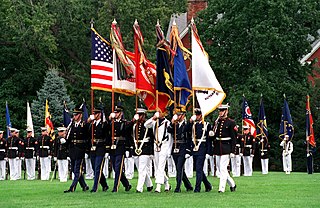 W
WThe several branches of the United States Armed Forces are represented by flags. Within the U.S. military, various flags fly on various occasions, and on various ships, bases, camps, and military academies.
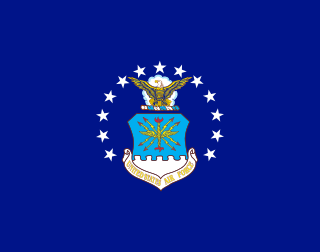 W
WThe flag of the United States Air Force was introduced in 1951 and consists of the U.S. Air Force's crest and shield, which itself comprises 13 white stars and the Department of the Air Force's coat of arms on a field of blue. The 13 stars represent the 13 original British American colonies, the three star grouping at the top portray the three Departments of the Department of Defense. The crest includes the North American bald eagle, the cloud formation depicts the creation of a new firmament, and the wreath, composed of six alternate folds of silver and blue, incorporates the colors of the basic shield design.
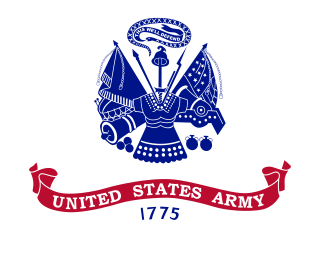 W
WThe flag of the United States Army displays a blue replica of the War Office Seal set on a white field. Beneath the seal is a broad scarlet scroll bearing the inscription in white letters, "United States Army". Beneath the scroll, in blue Hindu-Arabic numerals, is "1775", the year in which the Continental Army was created with the appointment of General George Washington as General of the Army. All of this is on a white background.
 W
WThe Bedford Flag is the oldest known flag in the United States. It is associated with the Minutemen of Bedford, Massachusetts, and the Battles of Lexington and Concord of 1775.
 W
WThe flag of the United States Coast Guard is white with a dark blue Great Seal of the United States; the shield on the eagle's breast has a blue chief over vertical red and white stripes. Inscribed in an arc above the eagle is "UNITED STATES COAST GUARD"; below the eagle is the Coast Guard motto, "SEMPER PARATUS" and beneath that in Arabic numerals is "1790". All inscriptions on the flag are in dark blue typeface.
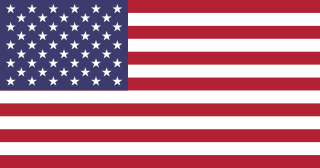 W
WThe ensign of the United States is the flag of the United States when worn as an ensign. International maritime law—see International Treaty on Law of the Sea, articles 91 and 92—provides that vessels have a "national character" and thus should display a flag (ensign) that corresponds to this national character, especially when in international or foreign waters. Vessels that are formally documented under the federal vessel documentation act, vessels owned by government bodies in the United States, and vessels in the U.S. military unquestionably have U.S. national character, and thus properly hoist a U.S. ensign to show their national character. Vessels that are numbered by the states and small, non-registered craft owned by U.S. citizens and not registered in other countries may also hoist a U.S. ensign to show their national character.
 W
WThe First Navy Jack was the naval jack of the United States from 1975 to 1976 and again from 2002 to 2019. It was authorized by the U.S. Navy and was flown from the jackstaff of commissioned vessels of the U.S. Navy while moored pierside or at anchor. Since then, it is used only as a naval jack by the oldest active warship in the U.S. Navy. The design is traditionally regarded as that of the first U.S. naval jack, flown soon after independence, but this is not supported by the historical record.
 W
WThe Fort Mercer Flag is a variant of the American flag flown at Fort Mercer around 1777 during the American Revolution. This unique flag had inverted colors similar to that of the Serapis flag. Some replicas of the flag usually contain inverted stars and a wider ratio.
 W
WThe Gadsden flag is a historical American flag with a yellow field depicting a timber rattlesnake coiled and ready to strike. Beneath the rattlesnake are the words: "Dont Tread on Me". Some modern versions of the flag include an apostrophe.
 W
WThe George Rogers Clark Flag is a red and green striped banner in the model of American Flags commonly associated with George Rogers Clark, although Colonel Clark did not campaign under these colors. The "Clark" flag was made in Vincennes, Indiana, and likely flew over Fort Sackville even before Clark arrived.
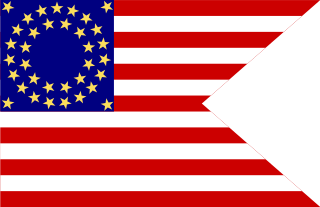 W
WIn the United States Army, Navy, Air Force, Marine Corps and Coast Guard, a guidon is a military standard that company/battery/troop or platoon-sized detachments carry to signify their unit designation and branch/corps affiliation or the title of the individual who carries it. A basic guidon can be rectangular, but sometimes has a triangular portion removed from the fly.
 W
WThe jack of the United States is a maritime flag representing U.S. nationality, flown on the jackstaff in the bow of U.S. vessels that are moored or anchored. The U.S. Navy is a prime user of jacks for its warships and auxiliaries, but they are also used by non-naval vessels such as ships of the U.S. Coast Guard, the predominantly civilian-crewed replenishment and support ships of the U.S. Navy's Military Sealift Command, the ships of the National Oceanic and Atmospheric Administration, and other U.S. governmental entities. The jack is flown on the bow (front) of a ship and the ensign is flown on the stern (rear) of a ship when anchored or moored. Once under way, the ensign is flown from the main mast and the jack is lowered, removed, and stowed away for future use.
 W
WThe flag of the United States Marine Corps is the flag used to represent the U.S. Marine Corps, as well as its subsidiary units and formations.
 W
WThe flag of the United States Navy consists of the seal of the U.S. Department of the Navy in the center, above a yellow scroll inscribed "United States Navy" in dark blue letters, against a dark blue background.
 W
WReligious symbolism in the United States military includes the use of religious symbols for military chaplain insignia, uniforms, emblems, flags, and chapels; symbolic gestures, actions, and words used in military rituals and ceremonies; and religious symbols or designations used in areas such as headstones and markers in national cemeteries, and military ID tags.
 W
WSerapis is a name given to an unconventional, early United States ensign flown from the captured British frigate Serapis.
 W
WA service flag or service banner is a banner that family members of those serving in the United States Armed Forces can display. The flag or banner is officially defined as a white field with a red border, with a blue star for each family member serving in the Armed Forces of the United States during any period of war or hostilities. A gold star represents a family member who died during military operations, including those who lost their lives during World War I, World War II, or any subsequent period of armed hostilities in which the United States was engaged before July 1, 1958, and those who lost or lose their lives after June 30, 1958:while engaged in an action against an enemy of the United States; while engaged in military operations involving conflict with an opposing foreign force; or while serving with friendly foreign forces engaged in an armed conflict in which the United States is not a belligerent party against an opposing armed force;
 W
WThe flag of the United States Space Force is the flag used to represent the United States Space Force, as well as its subsidiary units and formations. It was officially unveiled on 15 May 2020.
 W
WThe Star-Spangled Banner, or the Great Garrison Flag, was the garrison flag that flew over Fort McHenry in Baltimore Harbor during the naval portion of the Battle of Baltimore during the War of 1812. It is on exhibit at the National Museum of American History, Smithsonian Institution. Seeing the flag flying over Fort McHenry on the morning of September 14, 1814, after the battle ended, Francis Scott Key was inspired to write the poem "Defence of Fort M'Henry". These words were written by Key and set to the tune of "To Anacreon in Heaven" by John Stafford Smith, a popular song at the time. It was not until 1931 that the song became the national anthem of the United States.
 W
W